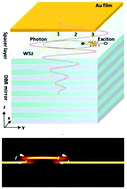Polaritonic manipulation based on the spin-selective optical Stark effect in the WS2 and Tamm plasmon hybrid structure
Abstract
Exciton–polaritons have shown great potential as a low-energy consumption and robust solid-state platform for photoelectronics integration and quantum information applications. Here, an all-optical method that uses the spin-sensitive optical Stark effect is proposed to manipulate exciton–polaritons for functional polaritonic operations. We use a Tamm plasmon and WS2 hybrid structure with a patterned transverse potential to form the channeled bright state of polaritons. An optical Stark pulse causes perturbation of the polaritonic potential, so as to control the tunneling of polaritons between isolated channels. Polaritonic operations such as switching, splitting and routing were proposed through properly setting of the optical Stark pulse (e.g., pulse width). In addition, spin-sensitive manipulation of the polaritons was proposed taking advantage of the valley-selective excitonic energy shifting induced by the polarized optical Stark pulse. These basic operations together with time-space programming of the optical Stark pulses would pave a way of routing and addressing of polaritons for future optoelectronic integration and networking.



 Please wait while we load your content...
Please wait while we load your content...